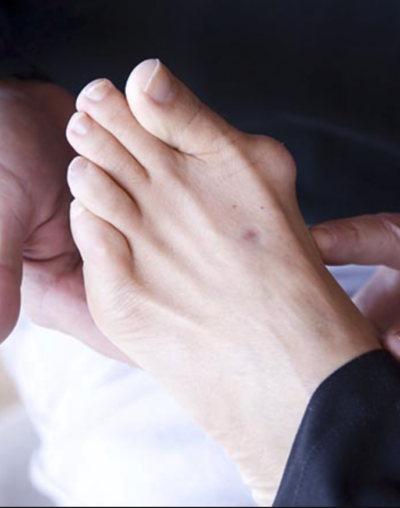What is a bunion?

A bunion (hallux valgus) is a bone deformity that results when the big toe moves out of place, causing enlargement of the metatarsophalangeal joint at its base. The enlarged joint pushes the toe down against the shoe wall, building considerable friction and pressure. If this happens at the bottom of the little toe, it’s called a “bunionette” or “tailor’s bunion.”
What is bunion surgery?
Bunion surgery is an operation to reduce pain and correct the deformity at the base of the big toe and ball of the foot.
Painful bunions often form after stress to the joint over a prolonged period. Tight, pointed, and confining shoes cause them to be seen more in women than men. Bunions may be inherited as a family trait or result from arthritis. Different forms of arthritis often affect the big toe joint.
Dr. Timothy Gateley, DPM, is an experienced podiatrist and skilled surgeon that provides surgical and conservative treatment of foot and ankle problems, including bunions.
Before surgery is considered, Dr. Gateley approaches bunion treatment with a two-step patient care plan. First, he seeks to relieve bunion pain symptoms and callus formation caused by friction. Then, he works to stop further development of the problem.
Prescribed treatment may include:
- A protective felt padding to shield inflamed skin from the shoe wall
- Removal of nearby corns and calluses
- Fitted footwear
- Orthotic inserts
- Nighttime splints
In some cases, a surgery called a bunionectomy might be necessary to correct the bunion completely. The goal of surgery is to relieve pain and correct as much deformity as possible. The surgery is not cosmetic and is needed to return proper function to the foot and big toe.
Other related modalities that help diagnose and plan appropriate treatment include X-rays of both feet.
Bunion Surgery FAQ
Frequently asked questions and answers about all things bunion surgery.
Dr. Gateley Will Help Get You Back On Your Feet
After surgery and recovery, our patients return to their daily activities, pursuits and life better than ever and free from foot and ankle pain.
His combination of surgical skills and caring demeanor with his patients makes Dr. Gateley one of the busiest foot and ankle surgeons in Topeka, Kansas.
If you’re ready to stop living with pain and live your best life, schedule a consultation today.



